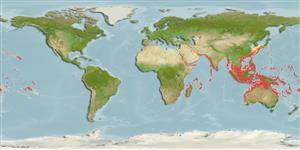Common names from other countries
分类 / Names
俗名 | 同种异名 | Catalog of Fishes(属, 种) | ITIS | CoL | WoRMS | Cloffa
Environment: milieu / climate zone / depth range / distribution range
生态学
海洋; 半咸淡水 礁区鱼类; 深度上下限 4 - 160 m (Ref. 5222), usually 20 - 45 m (Ref. 5222). 熱帶; 36°N - 35°S, 22°E - 124°W
Indo-Pacific: Red Sea to South Africa and eastward to the Pitcairn Group, north to Japan and Korea, south to the Arafura Sea (Ref. 9819), southern Queensland (Australia) and Lord Howe Island.
印度-太平洋: 紅海到南非與向東至皮特凱恩島群,北至日本與韓國, 南至阿拉弗拉海 (參考文獻 9819) ,昆士蘭南部 (澳洲) 與羅得豪島。
Length at first maturity / 大小 / 重量 / 年龄
Maturity: Lm ?, range 16 - ? cm
Max length : 52.0 cm TL 雄鱼/尚未辨别雌雄; (Ref. 1238); common length : 22.0 cm TL 雄鱼/尚未辨别雌雄; (Ref. 5450); 最大体重: 2.0 kg (Ref. 30874)
背棘 (总数) : 11; 背的软条 (总数) : 15 - 17; 臀棘: 3; 臀鳍软条: 8. This species is distinguished by the following characters: body depth 2.8-3.3 in SL (for specimens 10-26 cm SL); head length 2.3-2.6 in SL; flat interorbital area, convex dorsal head profile; snout length 4.3-5.1 in HL; preopercle rounded, rear edge serrate, with lower most serrae slightly enlarged; upper edge of operculum straight; midlateral part of lower jaw with 2-4 rows of teeth; gill rakers of first gill arch 6-8 + 15-17; pyloric caeca 10-16; caudal fin slightly to moderately rounded (Central-Pacific often with truncate caudal fins); ctenoid scales on body except cycloid anterodorsally above lateral line and on thorax and ventrally on abdomen, with numerous auxiliary scales; nape and dorsoposterior part of head densely covered with minute auxiliary scales; lateral-line scales 49-75. Colour variable, ranging from pale greenish grey to pale reddish yellow to scarlet; body often with 5 or 6 faint dark bars, the last on peduncle; body scales (except ventrally) with pale centre and dark rear margin, producing a faint checked pattern; the outer triangular part of interspinous membranes of dorsal fin black (dark red in fish from Western Australia and in some specimens from deep water), with pale yellow or white spot behind tip of each spine (Ref. 39231, 89707, 90102).
Common in outer reef slopes at depths below 15 m, also occurs in protected bays and lagoons as shallow as 4 m. May also be found down to a depth of 160 m. At Madagascar it feeds night and day on brachyuran crabs, fishes, shrimps, and galatheid crabs (Ref. 6774). In Kenyan waters it feeds on crabs, stomatopods, fishes, ophiuroids, and octopus (Ref. 6448). In the Red Sea, mostly fishes and some crustaceans (mainly crabs) are consumed (Ref. 6699). Readily caught with hook-and-line, spear, traps, and gill nets (Ref. 39231)..
常见于外礁斜坡在深度在 15 公尺之下, 也出现于遮蔽的内湾与泻湖浅至 4 公尺中。 可能也被发现于向下至深度 160 公尺。 在马达加斯加它在日间与夜间捕食十足目螃蟹,鱼,虾与铠甲虾科螃蟹。 (参考文献 6774) 在肯尼亚水域中它吃螃蟹,口足目甲壳类,鱼,阳燧足与章鱼。 (参考文献 6448) 在红海,大部份鱼与一些甲壳动物 (主要地螃蟹) 被消费。 (参考文献 6699)
Life cycle and mating behavior
Maturities | 繁殖 | Spawnings | Egg(s) | Fecundities | 仔鱼
This species exhibits a combination of simultaneous and sequential hermaphroditism. Smaller individuals within a social group are simultaneous hermaphrodites, while the largest often lose female function and reproduce exclusively as a male (Ref. 103751).印度-太平洋: 紅海到南非與向東至皮特凱恩島群,北至日本與韓國, 南至阿拉弗拉海 (參考文獻 9819) ,昆士蘭南部 (澳洲) 與羅得豪島。
Heemstra, P.C. and J.E. Randall, 1993. FAO Species Catalogue. Vol. 16. Groupers of the world (family Serranidae, subfamily Epinephelinae). An annotated and illustrated catalogue of the grouper, rockcod, hind, coral grouper and lyretail species known to date. Rome: FAO. FAO Fish. Synop. 125(16):382 p. (Ref. 5222)
CITES (Ref. 128078)
Not Evaluated
人类利用
渔业: 商业性; 游钓鱼种: 是的; 水族馆: 商业性
工具
特别资料
下载 XML
网络资源
Estimates based on models
Preferred temperature (Ref.
115969): 24.5 - 29, mean 28 (based on 1100 cells).
Phylogenetic diversity index (Ref.
82804): PD
50 = 0.5000 [Uniqueness, from 0.5 = low to 2.0 = high].
Bayesian length-weight: a=0.01148 (0.01022 - 0.01289), b=3.03 (3.01 - 3.05), in cm Total Length, based on LWR estimates for this species (Ref.
93245).
营养阶层 (Ref.
69278): 3.7 ±0.4 se; based on diet studies.
回复力 (Ref.
120179): 低的, 最小族群倍增时间4.5 - 14 年 (K=0.16).
Fishing Vulnerability (Ref.
59153): Moderate to high vulnerability (54 of 100).
Climate Vulnerability (Ref.
125649): Moderate to high vulnerability (54 of 100).
